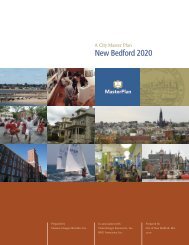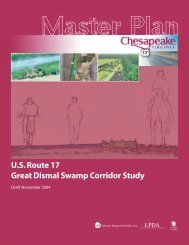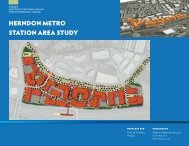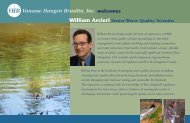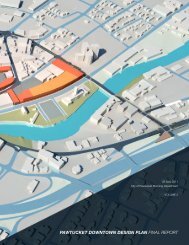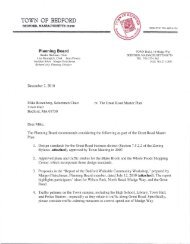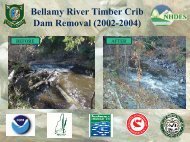Final Report - VHB.com
Final Report - VHB.com
Final Report - VHB.com
Create successful ePaper yourself
Turn your PDF publications into a flip-book with our unique Google optimized e-Paper software.
grocery store. The size of the pond is approximately 0.3 acre and outlets to a large<br />
scrub-shrub/forested wetlands.<br />
A large scrub-shrub/forested wetland (wetland 1-7) is located in a valley between<br />
two large <strong>com</strong>mercially developed parcels. Beaver flowage is found in central areas<br />
of the wetland, which receives flow from a perennial stream that originates on the<br />
NASB. The perennial stream meanders through the wetland, which outlets to a<br />
culvert under US Route 1. Prior to construction of US Route 1, this wetland was part<br />
of a larger wetland system located on the north side of US Route 1.<br />
Located on the western end of the Study Area is a large floodplain forest (wetland 1-<br />
8) that receives flow from multiple perennial streams. Most of the area consists of<br />
forested wetland habitat, with a strip of emergent wetland extending west along US<br />
Route 1. The wetland outlets via a culvert into a small emergent wetland on the north<br />
side of US Route 1.<br />
Two additional wetlands (wetland 1-9 and 1-10), located on the NASB, were not<br />
visited in the field due to their location on the base, but they are clearly visible in<br />
aerial photographs. Both wetlands are relatively small systems (i.e., less than 2 acres)<br />
and consist primarily of open-water habitat. The wetlands are connected by a<br />
perennial stream that originates on the southernmost wetlands and outlets under<br />
Bath Road via a culvert. The stream provides flow to previously described wetlands<br />
located on both the southern and northern sides of US Route 1.<br />
Strategy 2A<br />
NWI mapping indicated four small wetlands systems (wetland 2A-1and 2A-6) in the<br />
Strategy 2A Study Area. The windshield-level survey located six small wetlands on<br />
Lewiston Road, west of Exit 31. These wetlands consist of emergent, forested, and<br />
open-water wetlands. The largest wetland (i.e., wetland 2A-4) occurs in an island of<br />
forested wetlands area between the I-295 southbound on- and off-ramps. Two<br />
perennial streams also are located in this area, both along the I-295 on- and off-ramps<br />
at Exit 31.<br />
The portion of the Study Area east of Exit 31 and Main Street (US Route 201) in<br />
Topsham has experienced substantial development and contains relatively few<br />
wetland resources. NWI mapping did not identify any wetland systems in this area;<br />
however, the windshield-level survey identified two small emergent wetland<br />
systems: (1) along the I-295 northbound on-ramp (wetland 2A-7); and (2) on the<br />
south side of Lewiston Road at the outlet of a culverted perennial stream (wetland<br />
2A-8).<br />
On US Route 201 (Main Street) north of State Route 196, several wetlands (wetland<br />
2A-9) were located in a utility-line corridor adjacent to the entrance of Mount Ararat<br />
High School. These scrub-shrub/emergent wetland systems consist of areas of<br />
goldenrod, raspberry, jewel weed, and various sedges, with patchy areas of alder<br />
Existing Conditions 44



